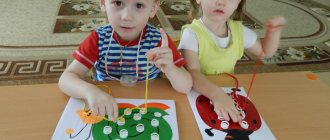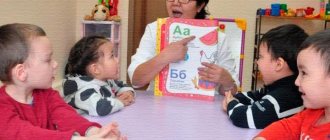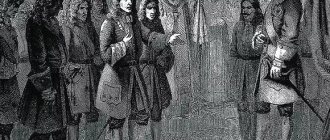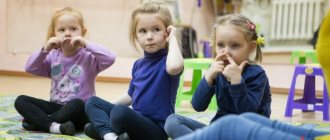Properties of motor skills and what causes them
Motor skills, i.e. the general physical preparation of a person and his development, are determined primarily by the correct construction and activity of the motor system. It is inextricably linked with the functioning of the nervous system. And, undoubtedly, the main role in performing various operations related to movement is played by the structure and condition of the osteo-articular and muscular system, spine, torso and limbs.
The components of motor skills are strength and endurance, coordination, body balance, as well as strength, mobility, reaction speed and ability.
There are 2 main types of motor skills - large and fine motor skills.
Fun exercises for older kids
Even simple exercises may have their contraindications depending on the developmental characteristics and health status of the baby. Therefore, before performing such exercises, it is necessary to consult with the pediatrician who is observing the baby. For example, diseases of the cardiovascular system may be a contraindication to active games and running. Allergic diseases require caution when using solutions for soap bubbles and playing with pillows (due to house dust); diseases of the musculoskeletal system limit riding a scooter or bicycle.
Catching up with soap bubbles
This game is suitable for kids who already walk and run confidently. On a walk or at home, blow soap bubbles and invite your baby to pop them with his palms.
It is impossible to predict the flight path of a soap bubble - that is why, trying to catch up with it, the baby will quickly change his movements, jump or, conversely, dodge.
Obstacle course
For this exercise we will need a balance bike, tricycle or scooter. Make obstacles out of plastic cones and invite your child to go around them. Another option for the exercise: draw a white line on the asphalt and ask your child to drive along it as smoothly as possible.
Aerialist
This is a home version of the chalk line exercise. Just place masking tape on the floor and let your little one walk across it with his arms outstretched. In addition, you can come up with a gaming legend. For example, that the ribbon is stretched high, high above the clouds, and the peaks of snow-white mountains are hidden under the legs.
Fine motor skills
Fine motor skills are the movements of the hand and fingers. It requires focus, attention and precision. For example, writing, drawing, carving, modeling clay, tying shoes, opening doors with keys, grabbing objects, sewing, fastening buttons, braiding hair, working on a computer using a mouse or touch screen.
(c)freepik.com
How is the child's motor skills developing?
A child's motor skills are consciously and unconsciously trained and improved from the first day after birth.
- As you know, by the sixth month of life, a baby should hold his head up and roll over from back to side. Be able to sit down holding an adult's finger.
- A baby up to one year of age must sit without support, crawl, put objects in containers, and hit them against each other.
- A child under 2 years old can walk, run, jump independently, arms wide apart, manipulate objects, roll a ball. And also climb up and down the stairs, holding onto the railings, and climb on your toes.
- A child under 3 years old should be able to climb stairs without the help of handrails and avoid obstacles. Definitely make attempts at self-care. However, he still needs support and help because his movements are not yet precise enough. During this period, basic “locomotive” actions are best mastered. The range of motor skills is expanding at a particularly rapid pace.
- Preschool child: Uses devices effectively, runs and jumps freely. His hand-eye coordination develops, his balance and vestibular apparatus improve, and his dexterity of movements is honed. By the end of the preschool period, the child fully masters all self-care skills. Able to combine several motor actions into a sequence. Grabs, throws, climbs a wall, a rope, over a fence. Copies the actions of others.
- Children of primary school age master almost half of the movements characteristic of an adult. They have skills in self-care, hygiene, care of clothes and room, and handling simple tools. Movements become harmonious, rhythmic and smooth. The age of 9-12 years is the “golden period of mobility.”
- During puberty, motor development tends to become unbalanced. There is a deterioration in the coordination of movements and the accuracy of their execution. In general, this is due to the fact that different organs and parts of the body develop in leaps and bounds. For example, for a couple of months only the legs grow rapidly, then the arms and neck. The growth of different organs and parts of the body is not interconnected. No wonder they say: “awkward, like a teenager.”
- By the age of 18-20, as a rule, the growth of the motor system is completed, the imbalances are leveled out and the quality of motor skills reaches the best levels.
Emerging difficulties
In the modern world it is very difficult to sufficiently develop motor skills.
Making life easier with all kinds of devices and gadgets means that children do not need to learn many basic actions. After all, there is Velcro on clothes, a zipper on shoes, machines will wash clothes and wash dishes. In learning, children often become a passive observer of changing material: for example, pictures on a computer monitor, while losing the opportunity to explore on their own. Therefore, it is important to keep your baby occupied literally from the very first day.
Fine and gross motor skills - how to improve?
The development of gross and fine motor skills is paramount not only for full physical fitness, but also for everyday life. In order for a child to correctly perform complex movements of fine motor skills, it is necessary to have a firmly laid foundation of gross motor skills. Therefore, the priority task is coordination of movements, that is, the development of general mobility. And then, on this basis, you can develop the child’s motor skills.
Coordination requires movement of large parts of the body - arms, legs, torso, back, neck. Fine motor skills require the improvement of small parts of the body, in particular the precise movements of the fingers and hands.
There is no need to reinvent the wheel here - the methods have been known for a long time. For gross motor skills, these are outdoor activities, daily exercise, swimming, running, jumping. It will be very useful to attend sports sections, and even just physical education lessons at school.
For fine motor skills - interest groups, housework, cleaning the apartment, harvesting in the garden, interactive games and educational programs. For example, on our training service iqclub. Among the games you will find “Clicker” and other exciting programs for children.
Development of general and fine motor skills of preschool children
Tatiana Nepeina
Development of general and fine motor skills of preschool children
“The origins of children’s abilities and gifts are at their fingertips. From them come the finest streams that feed the source of creative thought. In other words: the more skill in a child's hand, the smarter the child. "
It’s no longer a secret that the development of a child’s hand is closely related to the development of his speech and thinking.
Fine motor skills are fine movements of the hand. In adults, it reaches varying degrees of development: depending on the profession, training, etc. For a child, this is very important, since it affects the pace of his mental development and even the formation of speech.
The higher the child’s motor activity, the better his speech develops. When a child masters motor skills and abilities, coordination of movements develops. The formation of movements occurs with the participation of speech. Precise, dynamic execution of exercises for the legs, torso, arms, and head prepares for the improvement of the movements of the articulatory organs: lips, tongue, lower jaw, etc.
The development of fine movements of the fingers is especially closely related to the development of speech. Why does a person who cannot find the right word to explain often help himself with gestures?
Gross and fine motor skills should be developed in parallel. Using simple exercises to develop general motor skills—movements of the arms, legs, and torso—as an example, you can teach him to listen and remember tasks, and then carry them out.
Along with the development of motor skills, attention, memory, and speech will develop.
The influence of manual (manual) actions on the development of the human brain was known back in the 2nd century BC in China. Experts argued that games involving hands and fingers (such as our “White-sided Magpie” and others) bring the body and mind into harmonious relationships and keep the brain systems in excellent condition.
Japanese doctor Namikoshi Tokujiro created a healing technique for influencing the hands. He argued that fingers are endowed with a large number of receptors that send impulses to the human central nervous system. There are many acupuncture points on the hands, by massaging which you can influence the internal organs reflexively associated with them.
In China, palm exercises with stone and metal balls are common. The popularity of classes is explained by their healing and toning effect on the body. Regular exercises with balls improve the child’s memory and mental abilities, eliminate his emotional stress, improve the functioning of the cardiovascular and digestive systems, develop coordination of movements, strength and dexterity of the hands, maintain vitality and have a positive effect on the development of the child’s speech.
In Japan, palm and finger exercises with walnuts are widely used. Rolling a hexagonal pencil between your palms has an excellent healing and tonic effect.
The talent of our folk pedagogy created the games “Ladushki”, “White-sided Magpie”, “Horned Goat” and others. Their meaning is still not sufficiently understood by adults. Many parents see them as entertainment rather than as developmental and health-improving influences. The works of V. M. Bekhterev proved the influence of hand manipulation on the functions of higher nervous activity and speech development. Simple hand movements help remove tension not only from the hands themselves, but also from the lips, and relieve mental fatigue. The development of fine movements of the fingers precedes the appearance of syllable articulation.
Thanks to the development of fingers, a projection of the “scheme of the human body” is formed in the brain, and speech reactions are directly dependent on the fitness of the fingers. This training should begin from early childhood.
Based on the health-improving effects of each finger on the child’s body, help the child manipulate them in a coordinated and deft manner. Pay attention to the child’s mastery of simple, but at the same time vital skills - holding a cup, spoon, pencils, washing. For example, if at four years old he cannot carry a handful of water to his face, it means that his small muscles are lagging behind in the development.
Games and exercises to develop fine motor skills
Modeling from clay and plasticine
This is very useful and has a great effect on the development of fine motor skills, and you can sculpt not only from plasticine and clay. If it’s winter in the yard, what could be better than a snow woman or snowball fights. And in the summer you can build a fairytale castle from sand or small pebbles. Take every opportunity to improve your child's fine motor skills.
Drawing or coloring pictures is a favorite activity for preschoolers and a good exercise for developing fine motor skills. You need to pay attention to the children's drawings. Are they diverse? If a boy only draws cars and planes, and a girl draws dolls that are similar to each other, then this is unlikely to have a positive effect on the development of the child’s imaginative thinking. Making paper crafts. For example, cutting out geometric shapes yourself with scissors, making patterns, making appliqués. The child needs to be able to use scissors and glue. Based on the results of such work, you will be able to assess how developed the baby’s fine motor skills and finger movements are.
Making crafts from natural materials : pine cones, acorns, straw and other available materials. In addition to developing fine motor skills of the hands, these activities also develop the child’s imagination and fantasy.
Construction . Develops imaginative thinking, imagination, and fine motor skills.
Fastening and unfastening buttons , snaps, hooks. A good workout for fingers, improves dexterity and develops fine motor skills.
Tying and untying ribbons , laces, knots on a rope. Each such movement has a huge impact on the development of fine motor skills in the baby’s hands.
Twisting and untwisting lids of jars , bottles, etc. also improves the development of fine motor skills and finger dexterity for the child.
Suction of water with a pipette . Develops fine finger movements and improves overall hand motor skills.
Stringing beads and buttons . In the summer you can make beads from rowan berries, nuts, pumpkin and cucumber seeds, small fruits, etc. An interesting activity for developing imagination, fantasy and fine motor skills.
Weaving braids from threads , wreaths from flowers.
All types of handicrafts: for girls - knitting, embroidery, etc., for boys - chasing, burning, artistic sawing, etc. Teach your children everything you know!
Sorting cereals , pour, for example, peas, buckwheat and rice into a small saucer and ask the child to sort. Development of touch, fine movements of fingers.
Exercises for the development of tactile sensitivity and complexly coordinated movements of the fingers and hands
1. The child puts his hands into a vessel filled with some homogeneous filler (water, sand, various cereals, pellets, any small objects) . 5 - 10 minutes, as if mixing the contents. Then he is offered a vessel with a different filler texture. After several trials, the child, with his eyes closed, puts his hand into the offered vessel and tries to guess its contents without feeling its individual elements with his fingers.
2. Identification of figures , numbers or letters “written” on the right and left hand.
3. Identification of an object, letter, number by touch alternately with the right and left hand . A more complex option - the child feels the proposed object with one hand, and sketches it with the other hand (with open eyes).
4. Modeling geometric shapes, letters, numbers from plasticine . For school-age children, modeling not only printed but also capital letters. Then recognition of molded letters with eyes closed. Starting position - sitting on your knees and on your heels. The arms are bent at the elbows, palms facing forward. The thumb is opposed to the rest. At the same time, with both hands, two slaps are made with each finger on the thumb, starting from the second to the fifth and back.
5. “Rubber band” . For this exercise, you can use a hair elastic with a diameter of 4-5 centimeters. All fingers are inserted into the elastic band. The task is to use all your fingers to move the elastic band 360%, first to one side and then to the other. It is performed first with one hand, then with the other.
6. Roll the pencil between the fingers from the thumb to the little finger and back, alternately with each hand.
7. Game “Multi-colored snowflakes” (age – 4-5 years). Aimed at developing fine motor skills and neatness. Materials: felt-tip pens, white paper, scissors. Have the children color the snowflakes. Since the snowflakes turn out to be openwork, it is necessary that the paper be stronger. Painting movements affect the development of fine motor skills of the hands.
8. Repeat the movement” (a version of B.P. Nikitin’s game “Monkeys”) An adult, sitting opposite the child, makes some “figure” with the fingers of his hand (some fingers are bent, some are straightened - any combination). The child must bring the fingers of his hand into exactly the same position - repeat the “figure”. The task here is complicated by the fact that he still needs to mirror it (after all, the adult is sitting opposite). If this task causes difficulties for the child, then you can first practice by doing the exercise while sitting next to (and not opposite the child). This will make it easier for him to copy the position of his fingers.
9. Drawing games If a child has poorly developed fine motor skills and finds it difficult to learn to write, then you can play drawing games. For example, race to trace squares or circles or move through a labyrinth drawn in advance (the most interesting thing is when a child draws a labyrinth for a parent, and a parent for a child. And everyone tries to draw more intricately). Now there are many different stencils of various geometric shapes on sale.
10. Games with household items
The advantage of the following games for the development of fine motor skills in children is that they do not require any special toys, aids, etc. The games use available materials that are found in any home: clothespins, buttons, beads, cereals etc.
Take a bright tray. Sprinkle any small grains onto a tray in a thin, even layer. Run your baby's finger over the rump. You will get a bright contrasting line. Let your child draw a few chaotic lines himself. Then try to draw some objects together (fence, rain, waves, letters, etc.
11. Choose buttons of different colors and sizes . First, lay out the drawing yourself, then ask your child to do the same on his own. After the child learns to complete the task without your help, invite him to come up with his own versions of the drawings. From a button mosaic you can make a tumbler, a butterfly, a snowman, balls, beads, etc., animals, but, in principle, they are easy to make yourself.
Give your child a round hair brush . The child rolls the brush between his palms, saying: “The pine, the fir, the Christmas tree have very sharp needles. But the juniper will prick you even more powerfully than the spruce tree.” Take a sink grate (usually it consists of many squares). The child walks with his index and middle fingers, like legs, along these cells, trying to take steps on each stressed syllable. You can “walk” alternately with one hand or the other, or you can do it with both hands at the same time, saying: “We wandered around the zoo, approached each cage and looked at everyone in a row: bear cubs, wolf cubs, beaver cubs.”
Let's take the dumpling maker . Its surface, as you remember, is similar to a honeycomb. The kid uses two fingers (index and middle) to depict a bee flying over the honeycombs: “Fingers, like bees, fly over the honeycombs And they enter each one with a check: what is there? Will there be enough honey for all of us until spring, So that we don’t have hungry dreams?”
Pour 1 kg of peas or beans . The child puts his hands in there and imitates how the dough is kneaded, saying: “Knead, knead the dough, There is room in the oven. There will be buns and rolls coming out of the oven.”
Pour dry peas into a mug. For each stressed syllable, the child transfers the peas, one at a time, to another mug. First with one hand, then with both hands at the same time, alternately with the thumb and middle finger, thumb and ring finger, thumb and little finger. Any quatrains can be selected. Place the peas on a saucer. The child takes a pea with his thumb and forefinger and holds it with the other fingers (as when picking berries, then takes the next pea, then another and another - so he picks up a whole handful. You can do this with one or two hands.
Using a clothespin (check on your fingers to make sure it is not too tight), we alternately “bite” the nail phalanges (from the index to the little finger and back) on the stressed syllables of the verse: “The silly kitten bites hard, He thinks it’s not a finger, but a mouse . (Change of hands.) But I’m playing with you, baby, And if you bite, I’ll tell you: “Shoo!”
Take a rope (as thick as a child’s little finger) and tie 12 knots on it. The child, fingering the knots with his fingers, names the month of the year in order for each knot. You can make similar devices from beads, buttons, etc. We stretch the rope at the level of the child’s shoulders and give him several clothespins. For each stressed syllable, the child attaches a clothespin to the rope: “I will deftly pin the clothespins onto my mother’s rope.”
two caps from plastic bottles on the table with the threads facing up. These are “skis”. The index and middle fingers stand in them like feet. We move on “skis”, taking one step for each stressed syllable: “We are skiing, we are rushing down the mountain, We love the fun of the cold winter.”
You can try to do the same with both hands at the same time.
The child collects matches (or counting sticks) with the same fingers of different hands (pads): two index fingers, two middle fingers, etc. We build a “log house” from matches or counting sticks. The higher and smoother the log house, the better. Starting from a corner, the child crumples a handkerchief (or plastic bag) so that it all fits in his fist.
The child rolls a walnut between his palms and says: “I roll my walnut so that it becomes rounder than everyone else.” The child holds two walnuts in one hand and rotates them around one another.
12. Games - lacing : - develop sensorimotor coordination, fine motor skills of the hands; - develop spatial orientation, promote understanding of the concepts of “above”, “below”, “right”, “left”; - form lacing skills (lacing, tying a lace into a bow ); - contribute to the development of speech; - develop creative abilities.
Games with lacing also develop the eye, attention, strengthen the fingers and the entire hand (fine motor skills, and this in turn affects the formation of the brain and the development of speech. And also, which is not unimportant, lacing games indirectly prepare the hand for writing and develop perseverance.
Subject-based activities also contribute to the development of fine motor skills:
Fastening and unfastening buttons.
Lacing shoes, tying and untying knots.
Games with mosaics.
Games with constructors.
Sorting through cereals, grains, beads.
Stringing beads on a thread, rewinding the threads (calms hyperactive children).
Walking with your fingers on the bars.
Family education is of great importance in the development of gross and fine motor skills in a child. Remember that the smarter your hands, the smarter your child. Only through the joint “common cause” of parents and child will a good positive result be achieved.







